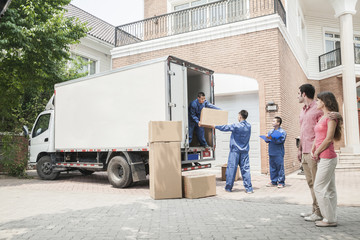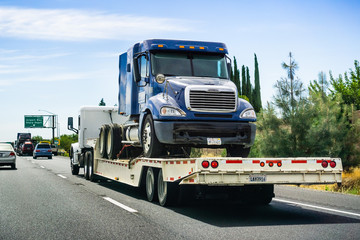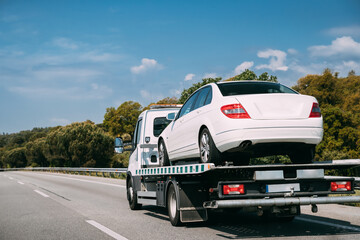The Benefits of Hiring a Moving Company
Whether you’re moving across the street or across the country, a reliable Moving Company can help you get there. They’ll pack your belongings, transport them safely, and unpack them once they arrive at their destination.

And they’ll do it all for less than you might expect. Keep reading to learn more about the benefits of hiring a moving company.
When you hire movers, you don’t have to worry about purchasing any of the materials that go into packing up your belongings. The company will bring all of the boxes, bubble wrap, and tape that is needed to get your belongings from point A to point B safely. This can save you a lot of time and money in the long run.
Moving can be a very physically exhausting process. Lifting heavy boxes up and down stairs or across long distances can take a toll on your back, shoulders, and neck. If you’re not careful, this type of strain can lead to serious health problems such as hernias or muscle injuries.
Professional movers know how to handle heavy items and will take the proper precautions when loading them into the truck. They will also take care to properly arrange the boxes and furniture in order to make the most efficient use of the space in the truck. This will help to prevent damage and reduce the risk of injury.
When hiring a full-service moving company, be sure to get estimates from at least three different companies. This will give you a better idea of what to expect and help you to negotiate a fair price. Make sure that the estimates are based on in-home surveys or detailed inventories of your belongings, not just guesses over the phone.
In addition to basic packing and moving services, many full-service movers also offer accessorial services such as crating (for valuable, oddly-shaped breakables), disassembly/reassembly of furniture, shuttle service (for properties that are not accessible by large trucks), storage services (if your new home isn’t ready when you move out), and junk removal services. If you have a special need, ask your moving company during the quoting process whether they can accommodate it.
You don’t have to worry about purchasing the materials
Many moving companies provide all of the materials necessary to complete the move. This includes everything from cardboard boxes to packing paper and tape. They may also offer additional services such as cleaning supplies and moving blankets. They will also help you plan the logistics of your move, such as arranging utility services and filing change-of-address forms.
Cardboard boxes are an important part of any move, so make sure you have a variety of sizes available. You’ll also need plenty of bubble wrap and packing paper. You can get free cardboard boxes from local businesses, which often have excess boxes they need to dispose of after unpacking inventory. You can also ask friends and neighbors to save their boxes. You can even post a request for boxes on social media.
Other packing materials you may need include garbage bags and plastic baggies. These are useful for transporting small items, such as jewelry and screws. You can also use plastic bags to protect mattresses and pillows. You might also want to invest in some reusable padded envelopes, which are great for electronics and fragile items.
In addition to these materials, you’ll need some heavy duty tape. This can be used to reinforce the bottoms and corners of boxes and to seal them up once they’re full. You should also have some packing peanuts and newspaper on hand to provide extra cushioning for delicate items. You can also buy foam sheets to create a fitting cushioning for irregularly shaped items.
You’ll also need to have a pen and a piece of paper to write down each box’s contents. This will help you keep track of all your belongings during the move and ensure that all of them made it to your new home. You should also have a tool set handy, as you may need to disassemble some of your larger furniture pieces to fit them into the moving truck and through doorways.
You don’t have to worry about the safety of your belongings
Professional movers know how to handle your belongings with care. They also take a thorough inventory before the move and create a complete list of everything being transported. This helps prevent anything from getting lost or damaged during the move. It also makes it much easier to file a claim if something does go wrong.
If you try to move things yourself, you may not have the right equipment to do the job properly. This includes everything from sturdy boxes that won’t collapse if stuffed to heavy-duty bubble wrap for fragile items. You might even need dollies for weighty pieces that a single person can’t reasonably lift on their own. Professional movers come prepared with all of the best equipment for the job, so you can rest assured knowing your belongings are in good hands.
One of the biggest safety concerns during a move is that you could injure yourself. This is especially true if you’re handling heavy items or working on precarious surfaces. Moving can be exhausting, which is a recipe for injury. Aside from that, there are a number of other hazards that can pop up during a move. For example, tripping over furniture or other obstacles is common during a move. This can be dangerous, particularly if you’re wearing heels or carrying something in your hands.
Another big risk is being scammed by a dishonest moving company. This is especially true if you’re dealing with an interstate move. If you’re suspicious of a moving company, check their reputation with the Better Business Bureau and your local consumer protection agency before hiring them. Be wary of any company that requires a large deposit or other upfront payment. They should only require a small amount, like 20 percent of the total estimated cost of the move, and they should not hold your possessions hostage until you pay them.
You don’t have to deal with the logistics
The logistics of a move can be complex, but a moving company will handle all the details. This includes packing and labeling, loading and unloading, transportation, insurance, and coordinating with third-party shipping companies to complete the move. This can save you time and money by eliminating the need to rent a truck, hire helpers, and deal with other transportation costs.
The company will also provide a Bill of Lading, which recaps important information about your shipment. It lists all services requested, as well as the pick-up and delivery dates. The company will also provide storage in transit (SIT), which allows you to keep your belongings safe while your home or office is being prepared for your arrival.
Choosing the right business structure is one of the most important decisions you’ll make when starting a moving company. You can choose a sole proprietorship or partnership, depending on your preferences and needs. You will need to have liability and cargo insurance, as well as a business license.
Marketing your business can be daunting, but with some creativity and effort, you can get the word out. Use social media to reach out to your target audience, and consider distributing business cards and flyers to local businesses. You can also advertise your business through websites, which will allow customers to submit an online quote and learn more about the services you offer.
When it comes to pricing, it’s best to shop around and find a company that offers competitive rates. Be sure to factor in extra charges such as mileage fees, and don’t be afraid to ask for a breakdown of the cost. If you’re planning to hire employees, it’s also a good idea to include payroll taxes and employee benefits in your budget.
You don’t have to worry about the cost
When you hire a moving company, you can rest assured that your belongings will be safely transported to your new home. They have the experience and equipment to do this efficiently, which can save you a lot of time. Additionally, they can provide you with a free estimate, which is useful for budgeting your move.
When hiring a moving company, you should always shop around for the best price. You can ask friends and family members for recommendations, or you can do an online search. It is also helpful to read feedback from previous customers to get a better idea of how the company operates.
Another thing to keep in mind is that some companies offer additional services for an extra cost. For example, some companies offer cleaning services, while others can store your belongings for a period of time. In addition, some companies can ship your vehicle if you are moving across the country, while others can transport pets.
You should also consider the cost of additional insurance for high-value items. Most moving companies will include released liability coverage as part of the basic move price, but they may charge extra for valuation coverage. This type of coverage will reimburse you for the actual value of your items if they are lost or damaged during transit.
In addition to these advantages, moving companies can take care of your furniture and other large appliances. They can even handle the packing and unpacking for you, which can save you a lot of hassle. In addition, they can help you with customs clearance when moving to a different country. This can be a huge relief, as understanding the rules and regulations associated with this process is often difficult.
What You Should Know About Car Wraps
Sarasota Car Wraps are a great way to draw attention to your company’s message or logo. They also provide a cost-effective alternative to repainting.

Car wraps come in an almost endless array of colors and designs. They can even mimic other materials like carbon fiber and leather. However, finding a shop with an experienced team is key.
Car wraps offer the ability to transform your vehicle with a unique, customized, and permanent look. They are an excellent choice for promoting your business or brand, offering much more flexibility than painted graphics or traditional vinyl lettering for vehicles. They also provide an extra layer of protection to your paint job from the hostile elements like UV exposure, bird droppings, hard water deposits, road salt, tree sap, and more. They can also be easily removed, allowing you to return your car to its original condition.
The color and design of your wrap can be as simple or complex as you want. Bold colors can convey a sense of energy or power while more neutral hues can promote a professional, elegant image. A wrap’s colors should also coordinate with the accents on your vehicle like wheels, badges, and windows. For example, a sleek sports car could benefit from wrap colors that match the red brake calipers or wheels. Conversely, an SUV would look great with wrap colors that complement its rugged features.
Once you have decided on a design or style, your installer will prepare the vehicle for application. This includes a thorough wash and possibly a power wash in order to ensure that the surface is smooth. The shop may also remove the bumper covers, headlights, and taillights in order to access difficult areas for better application.
Wraps come in many different finishes and textures, from glossy or matte to brushed or carbon fiber. Regardless of the texture, your wrap can be printed with anything from a simple graphic to a full-color photo. Some even have a textured finish that can be felt when you run your hand over it.
Aside from the visuals, the durability of your wrap is important as well. Most car wraps are rated to last five years or more without fading, chipping, or peeling. They are also easy to maintain, as they simply require washing with mild pH-balanced soap and water. They can also be repaired if they get scratched or damaged. This makes them a wise investment for drivers who are interested in changing their car’s appearance but want to safeguard their original paint.
Vinyl Finishes
The color and design elements of your car wrap are important, but you should also consider the finish. The type of finish will affect how long the wrap lasts, how it looks and feels to the touch, and whether it is suitable for your vehicle. There are several different finishes available, including gloss, matte, metallic and textured vinyls. Each of these finishes has a distinct visual and tactile effect that can make your vehicle stand out.
Matte gunmetal gray, for example, has a non-reflective matte texture and muted hue that exudes robust modernity. Glossy black, on the other hand, is a classic that exudes a subtle allure and sophisticated charm. And glossy metallic vampire red evokes a daring essence that captivates observers.
Unlike paint, which is typically solid or two-toned (for that popular two-toned look), car wraps can be customized with a wide range of imagery, graphics and text. Moreover, they can protect the original paintwork by acting as a barrier against scratches, fading and other environmental damage. They can even be removed without damaging the paint underneath, allowing for easy restoration or change of appearance in the future.
When deciding on a wrap, you must first decide whether you want the wrap to cover your entire car or just a section. This will influence how much it costs, as well as the amount of work needed to prep your vehicle for the application. It is important to note that a wrap will not hide imperfections on your existing car, such as dings and scratches, so it’s best to get these repaired before applying the wrap. Likewise, rust or chipped paint can cause the decals to adhere poorly.
Depending on the material and quality, a wrap can last 2-10 years, or longer if properly cared for. Storing your vehicle indoors overnight, not parking under trees, such as maple or elm, that drop sap and keeping the vehicle out of direct sunlight will all help extend the lifespan of a wrap.
Installation
Whether you’re an individual who wants to enhance the appearance of your vehicle or a company seeking to promote its brand, car wraps offer a cost-effective alternative to painting your vehicles. Car wrapping can also be quicker to apply, which allows you to get your vehicles back on the road sooner. However, it’s important to know the process of car wrapping to ensure that you receive a high-quality finished product.
Before applying a car wrap, the shop that’s doing it will thoroughly clean the surface. This includes using a degreaser to remove any impurities, which could affect the adherence of the vinyl. This also enables the installer to easily work around and through obstacles like door handles, mirrors, and trims. In addition, it’s important that the shop works on a warm day, as vinyl and adhesive work best at about 68 degrees.
Once the vehicle has been cleaned, it’s recommended to let the wrap dry. This may take a few hours. During this time, the installer will likely dismantle the vehicle, including removing the bumpers, headlights, and taillights. This enables the installer to reach hard-to-reach areas and tuck the vinyl into the contours of the body panels. It’s also crucial that any hindrances are removed, as vinyl can easily tear or peel if it’s caught on something.
The next step is to design the wrap. This can be done by hiring a graphic designer or using a template provided by the wrap manufacturer. It’s important that the design fits properly to scale and that it matches the printer file requirements of the wrap material. The designer should also Photoshop the design onto a photo of the vehicle to check for any issues.
Once the design has been approved, it’s time to print the wrap. This is typically done by a large-format printer that can handle the dimensions of the vehicle. Once the wrap has been printed, it’s applied to the vehicle by a team of skilled installers. This can take a few hours, but it’s essential that the installation is completed correctly to prevent bubbles and wrinkles.
Maintenance
Car wraps can be more durable than a paint job, but they can still be damaged by weather and road debris. It is important to get any damage fixed as soon as possible to prevent it from worsening over time and compromising the integrity of the wrap.
The easiest way to protect your car wrap is to keep it clean. Washing it regularly with a gentle soap solution will help remove dirt and road grime. You should avoid using harsh chemicals or abrasive tools that could damage the wrap. If you do need to use a chemical cleaner, test it on a small section of the wrap before applying it to your entire vehicle.
Regularly waxing your vehicle will also help to maintain its appearance and prolong the life of the wrap. However, the most important step is to ensure that the body of your vehicle is free of cracks and chips. These can scratch the surface of your wrap, causing it to lose its sheen and dull in color.
Another thing to remember is to be careful when driving your car. It is not a good idea to take it off-road or on gravel roads, and you should slow down when driving over potholes and other uneven surfaces. The sharp edges of rocks and pebbles can easily scratch a vinyl car wrap.
Car wraps are an excellent choice for personalizing your vehicle or promoting a business. They offer a more cost-effective and versatile option than painting. In addition, they can be quickly and easily removed if you decide to sell your vehicle or return it to its original state. A new paint job, on the other hand, will likely decrease your resale value because potential buyers are unlikely to want an unconventional color.
It is also worth noting that wrapping your car is a much faster process than painting it. While a paint job can take days, a car wrap will usually be completed within hours. This is especially true if the car has been pre-wrapped by an experienced team of professional installers.



